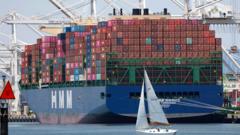Is Trump Really Increasing Canada's Trade Tariff to 35%?

Understanding the Impact of Trump's Tariff Increases on Canada and Global Trade
In recent months, the economic landscape has witnessed significant shifts, particularly with the rise of tariffs imposed by the Trump administration. The latest escalation, which includes a staggering 35% tariff on Canadian goods, has stirred up discussions about the future of trade relations between the United States and its key partners. This article delves into the implications of these tariffs, their connection to the ongoing trade war, and how they affect both the U.S. economy and international trade dynamics.
The Context of the Tariff Increase
Tariffs, essentially taxes on imported goods, serve as a tool for governments to protect domestic industries from foreign competition. In this case, President Trump has justified the increased tariff on Canada by citing the need to curb the flow of fentanyl and other drugs across the U.S. border. This move has been framed as a response to what the administration perceives as Canada’s failure to adequately address drug trafficking issues.
Despite the aggressive tariff increase, most Canadian goods will remain exempt due to the existing United States-Mexico-Canada Agreement (USMCA). This trade deal, which replaced NAFTA, allows nearly 90% of Canadian goods to enter the U.S. without facing the new high tariffs. Essential goods such as fresh produce, energy exports, and various industrial products retain their duty-free status, thanks to this agreement.
Key Goods Affected by the New Tariffs
While the USMCA provides a cushion for many Canadian imports, several specific categories are still vulnerable to tariffs under the new regime. These include:
- Dairy Products
- Wood Products
- Leather Goods
The fate of these imports will depend on the outcome of ongoing negotiations between the U.S. and Canada. As discussions evolve, the risk of tariffs on these products could fluctuate, creating uncertainty for businesses and consumers alike.
The Broader Picture of Tariff Increases
The 35% tariff is not an isolated incident; rather, it is part of a larger strategy by the Trump administration to reshape global trade. Alongside the tariff on Canada, Trump has imposed sweeping tariffs on numerous countries, affecting a wide range of goods. The rates vary significantly, with some nations receiving as high as 50% tariffs, while others face baseline duties of 10%.
This approach has drawn criticism from economists and analysts who argue that such tariffs will ultimately result in higher prices for American consumers and businesses. The White House, however, has maintained that these measures will lead to a stronger U.S. economy by reducing the trade deficit and encouraging domestic production.
The Economic Implications of Tariffs
The economic implications of these tariffs are extensive and multifaceted. Here are some key points to consider:
- Increased Costs for Consumers: Higher tariffs on imported goods typically lead to increased prices for consumers. Businesses facing higher costs may pass these expenses onto shoppers, leading to inflationary pressures in the economy.
- Impact on Domestic Industries: While tariffs aim to protect certain industries, they may inadvertently harm others. For example, industries reliant on imported materials may see their costs rise, potentially affecting profitability and employment.
- Global Supply Chains: Many companies operate within global supply chains, sourcing materials and components from various countries. Tariffs disrupt these networks, leading to inefficiencies and increased costs.
- Retaliation from Other Countries: Countries affected by U.S. tariffs may respond with their own tariffs on American goods, leading to a cycle of retaliation that can further strain international relations and economic stability.
Tariff Effects on Specific Industries
Different industries will experience the impact of these tariffs in varying degrees. Below are some sectors that are likely to be particularly affected:
- Automotive Industry: Tariffs on imported vehicles and parts can increase production costs for manufacturers, potentially leading to higher prices for consumers and reduced sales.
- Agriculture: Farmers relying on exports may face challenges if countries retaliate with tariffs on agricultural products, impacting their bottom line.
- Technology: The tech industry, which often depends on global supply chains, may experience delays and cost increases due to tariffs on electronic components.
Negotiations and Future Outlook
The ongoing negotiations between the U.S. and various trade partners will be crucial in determining the future landscape of international trade. The Trump administration has indicated that it is open to discussions, but the outcomes remain uncertain. Key points of contention include:
- Trade Deficits: Reducing trade deficits will continue to be a priority for the U.S. government, influencing future negotiations.
- Reciprocal Tariffs: The concept of reciprocal tariffs, where countries impose tariffs in response to each other's economic policies, will likely remain a focal point in discussions.
- Investment Incentives: The U.S. may seek investment commitments from trade partners in exchange for more favorable tariff rates, complicating negotiations further.
FAQs about Tariffs and Trade
What are tariffs, and why are they imposed?
Tariffs are taxes imposed on imported goods. They are often enacted to protect domestic industries from foreign competition, to influence trade balances, or as a response to unfair trade practices.
How do tariffs affect consumers?
Tariffs can lead to higher prices for imported goods, which may be passed on to consumers. This can result in overall inflation, affecting purchasing power and consumer behavior.
What is the USMCA, and how does it relate to tariffs?
The United States-Mexico-Canada Agreement (USMCA) is a trade agreement that replaced NAFTA. It provides a framework for trade between the U.S., Canada, and Mexico, allowing many goods to be imported without facing tariffs.
What industries are most affected by tariffs?
Industries such as automotive, agriculture, and technology are particularly vulnerable to tariffs. These sectors rely heavily on international trade and can face increased costs and supply chain disruptions due to tariff implementations.
What is the potential long-term impact of these tariffs on the economy?
Long-term impacts may include increased prices for consumers, disruptions in global supply chains, potential retaliation from other countries, and shifts in investment patterns. Ultimately, these factors could weigh down economic growth and stability.
Conclusion
The recent increase in tariffs on Canadian goods, along with broader tariff measures against various countries, marks a significant moment in the evolving landscape of international trade. While these actions are aimed at protecting U.S. interests, the complex repercussions could reverberate through the global economy, affecting consumers, businesses, and diplomatic relations alike. As negotiations continue and the economic environment shifts, both consumers and businesses must remain vigilant and adaptable.
What strategies can businesses adopt to mitigate the impacts of increased tariffs? How will these changes shape the future of international trade? #Tariffs #TradeWar #Economy
Published: 2025-08-01 08:30:24 | Category: technology



